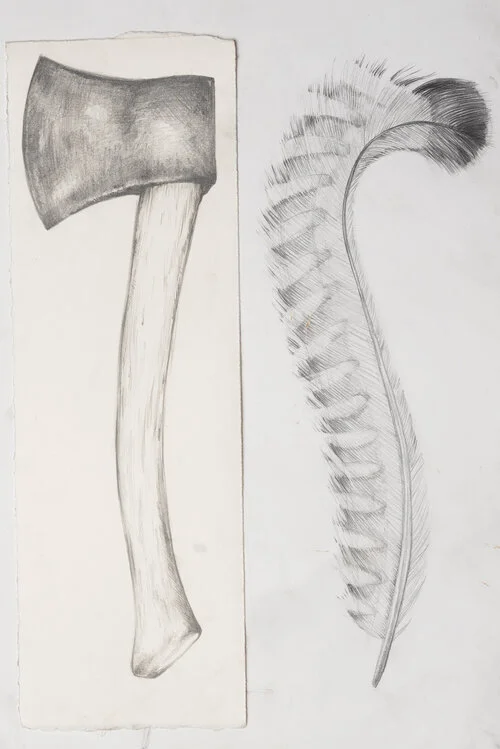Lyrebird feather colour study, 2020, pencil on BFK Rives. 50 x 16 cm. Image courtesy of the artist.
Axe colour study, 2020, pencil on BFK Rives. 50 x 16 cm. Image courtesy of the artist.
Axe study, 2020, pencil on BFK Rives. 50 x 16 cm. Image courtesy of the artist.
Lyrebird feather study, 2020, pencil on paper. 56 x 36 cm. Image courtesy of the artist.
Composition collage, 2020, pencil on paper. 56 x 36 cm. Image courtesy of the artist.
Traced composition, 2020, pencil on tracing paper. 52 x 45 cm. Image courtesy of the artist.
Traced in reverse, 2020, felt tip on tracing paper. 52 x 45 cm. Image courtesy of the artist.
Pre-etched plate, 2020, hardground on zinc. 50 x 41 cm. Image courtesy of the artist.
N’est Pas Une Liarbird (Wiritjiribin) 2nd State, 2018, etching on Velin Arches. 23.5 x 9 cm. Image courtesy of the artist.
Rebecca O’Shea
The work of Rebecca O’Shea intertwines real and imagined spaces to convey a story, exploring the meanings we attribute to objects and symbols, due to their connection with memory, knowledge and narrative. Her current work examines the fragility of nature, questioning human disruption and impact on the environment.
Drawing is the catalyst for O’Shea’s work, offering a medium to consider the nuance and complexities of objects. With studios closed, the lockdown has brought a bittersweet sabbatical-like period, one that both enables and inhibits a return to practice, and the development of new works. Due to the inability to etch or print, this collection of work peers behind the scenes into the process and development of an image, the final being transferred and scribed on the plate.
This un-etched plate builds on the concept of a previous work, n’est pas une liarbird (Wiritjiribin), pictured here in its second state. Each piece considers the unnatural noises the lyrebird famously imitates and how this, along with its name, is a telling reflection of the postcolonial condition. Perhaps previously, when the Dhawawal people referred to them as Wiritjiribin, the influence of human sounds on their repertoire was limited, whereas now, their mimicry includes alarms, car horns and chainsaws. In each piece a lyrebird feather is in juxtaposition with a man-made object, as a signifier of the demise of habitat as well as the environment more broadly. Through readdressing this concept with an axe, we are directed to colonial felling axes, symbolic of the beginning of the dramatic effects of human impact on the environment that continue to this day.
—
Rebecca O’Shea is a Sydney-based arts worker and emerging artist, with a practice engaging in printmaking and painting. O’Shea has an extensive background as an arts facilitator, having curated and exhibited at artists run initiatives in Wollongong as an undergraduate, after which she obtained a Masters of Arts Administration (2014) and worked for numerous public and private arts organisations. She is currently a technical assistant in Printmaking at UNSW Art & Design, and studio assistant for Cicada Press.
In 2018 her print, Back to Sky was featured in the artist book, ‘Postcards from the Edges: from Sydney and Cork to Santander’, first exhibited at Impact 10 in Santander, Spain. Subsequently it was granted the acquisitive prize to become a part of the Manly Art Gallery Museum’s artist book collection and was exhibited in Fremantle art prize in 2019.

